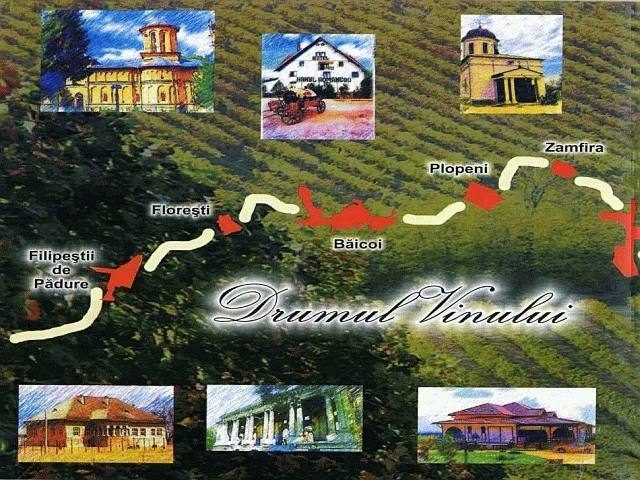The Prahova Contest, at the End
Our prize-winning contest “From the Wine Route to the Princes Route, dedicated to Prahova County, nears its end.

Daniel Onea, 13.03.2014, 12:18
We invite you to join us on a tour of the main cultural, tourist and historical landmarks in Prahova county, believed to be one of the richest and most developed in Romania. As usual, send us your answers to the questions we ask as part of the contest by 15 March, mailing date.
We begin with the Princes’ Route. This is a promotion scheme for historical sites in Prahova County.
Anca Baciu, General Secretary of the Association for the Promotion and Development of Tourism in the county, invited us to a great journey: “The Princes’ Route is a tourist trail for lovers of history and art. Tourists can see historical landmarks of the former principality of Wallachia, in our county of Prahova, traces of human existence on this territory, from the times of Vlad the Impaler, Michael the Brave and Matei Basarab. You can find the ruins of churches and palaces built by these princes, and various architecture monuments.”
Maneciu, the second largest village cluster in Prahova County, is included on the route.
Mihail Barbu, deputy mayor, told us about the beauty of the area and its tourist potential: “In this area we have an ancient Roman road. We also have the roads beaten by Michael the Brave and all the rulers of the principality. It is a place laden with history. The monasteries are proof of our rich past. They were financed by Romanians from Transylvania. One of them was financed by a rich princess, a widow who came from Transylvania and discovered this beautiful area. There she erected a nunnery, Suzana Monastery. There is also a monastery for monks, Cheia, built by refugees from Transylvania, which later rulers of Romania endowed with land to allow it to develop. The resort of Cheia sprang up around this monastery. The resort has 40 to 50 B&Bs, 3 hotels and 3 cabins, high up in the mountains. The main objectives are mountain tourism and high altitude trekking in the area of Ciucas, Zaganu and Grohotis mountains. Let us also not forget the beauty of these places, ideal for relaxation.”
Suzana Monastery is situated on the Teleajen Valley, in the north east of the county. It is an area of a rare beauty.
The mother superior of the monastery, Teofana Popescu, told us about one place you should not miss: “The painting is in the neoclassical style, and the saints are very large in size. The church is very wide, well lit, and the windows are generous, separating the paintings. The body of the church has four paintings of saints, and the western wall has three scenes. The altar screen dates back to the 19th century, and is adorned by icons from early 19th century, as well as by newer icons. The icons that degraded have been replaced by neoclassical icons.”
Prahova County, with its seat in Ploiesti, is among the richest in Romania. Its main natural resources are crude oil and natural gas, coal, gypsum, limestone, building stone, clays and mineral waters. We also have to mention vineyards. The Wine Route goes through the famous vineyards of Prahova County, including stopovers at mansions, princely courts and monasteries.
You will discover new things, such as the Dealu Mare Vineyard, which lies on parallel 45, like the regions of Bordeaux and Tuscany, and stretches over dozens of kilometers. You will also want to stop over in Valea Calugareasca, which boasts world-renowned wines, with prizes awarded abroad.
Mayor Vasile Neacsu: “Valea Calugareasca is one of the largest communes in the county. It has 11,000 inhabitants and is made up of 15 villages. Valea Calugareasca is famous for its red wines, such as Feteasca Neagra and Cabernet. The wine is sweet and aromatic due to the soil. This area used to be owned by monks, hence its name, that is “[Monk Valley” in Romanian. Here we have the Institute for Wine Growing and Making, which is famous worldwide. Here, wines are blended, grapes are selected, for producing various qualities of wine. The institute was set up in 1957, and now has over 300 ha of vineyards.”
The tourists choosing the Fruit Route can discover the rural world, with its celebrations and customs, learning about traditional crafts, and Prahova’s hills and orchards.
Andrei Nicolae, member of the Local Council in Valenii de Munte, who explains how important fruits are in the local culture: “As opposed to the other two projects, the Fruit Route links the places which are traditionally associated with fruit growing and processing, making preserves and drinks. In Valenii de Munte we have a festival of homemade liquors, where people come to display and promote their traditional fares. On top of this, each locality in the area has a specific event, such as a festival of mountains, a festival of mountain flowers, all tied into the traditional crafts in Teleajen Valley, all on this Fruit Route.”
We remind you that if you are the lucky winner of our contest, you will get a 9 day trip, full room and board, for two, between September 1st and 9th 2014.






























